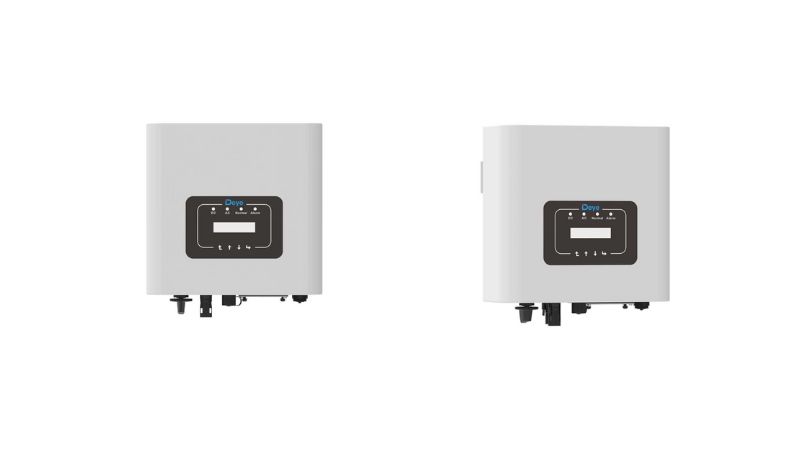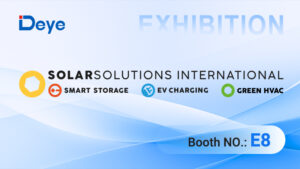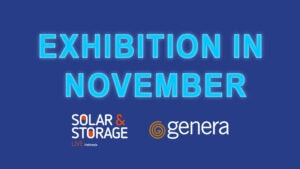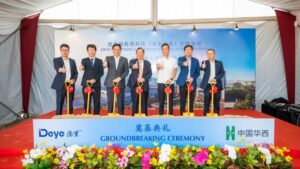Solar panels produce electricity, but not the kind your home can use directly. That’s where a single-phase string inverter comes in. This device converts the electricity from your solar panels into the type that powers your lights, appliances, and electronics.
A single-phase string inverter converts direct current (DC) electricity from solar panels into alternating current (AC) electricity used to power your home or business or send surplus energy to the grid. Named “string” inverters because they connect to a series (or “string”) of solar panels, they are both reliable and cost-effective. Popular choice for residential and small business solar installations.
Let’s explore why single-phase string inverters are so widely used and whether they’re right for your solar project.
Benefits of Single-Phase String Inverters
Cost-Effective for Homeowners
- Single-phase string inverters are straightforward, making them economical for residential setups between 3kW to 12kW.
- They require less complex wiring compared to other solar energy systems like microinverters, reducing installation costs.
- Maintenance is often less expensive as well. In case of failure, replacing one unit is more affordable than systems with distributed parts (e.g., microinverters).
User-Friendly Installation and Design
- These solar inverters are compact and easy for technicians to install, often requiring only a few hours.
- Installation kits include templates, mounting brackets, and plug-and-play connectors, simplifying setup.
- Easy access to displays and controls makes monitoring performance seamless.
High Efficiency
- Modern string inverters have efficiency ratings of 96-98%, ensuring minimal energy loss.
- Maximum Power Point Tracking (MPPT) technology optimizes energy extraction even under varying weather conditions.
- Advanced models such as the Deye SUN-(1-4)K-G04P1-EU-AM1 provide exceptional cost-efficiency by incorporating high-performance features like Maximum Power Point Tracking (MPPT) and comprehensive protection at competitive prices.
How Single Phase String Inverters Work
Single-phase string inverters:
- Collect DC electricity from solar panels connected in a string (or series).
- Boost input voltage using DC-DC converters.
- Convert DC into AC via power transistor circuitry.
- Smooth the output electricity into utility-grade AC power using filtering components.
They connect directly to residential grids (120V or 240V at 60Hz in the US). Additionally, they feature MPPT controllers to maximize power output efficiently, even during cloudy periods.
Single Phase vs. Three Phase Inverters
- Single-Phase Systems: Ideal for homes, using one uniform AC waveform to provide electricity. Typically range from 1kW to 12kW for moderate energy needs.
- Three-Phase Systems: Designed for larger commercial or industrial setups, delivering three offset AC waveforms for higher capacities and smoother power loads.
Main Components of Single Phase Inverters
Key parts of the inverter include:
- DC Input Terminals: Connect to the solar panel strings.
- MPPT Controllers: Optimize energy output via real-time adjustments.
- Inverter Bridge: Uses components like IGBTs to convert DC into AC.
- Filters: Smooth output AC electricity to meet grid quality standards.
- Monitoring Systems: Allow users to track performance via Wi-Fi, Ethernet, or mobile apps.
- Safety Features: Include surge and fault protection to prevent dangerous situations.
Applications of Single-Phase Inverters
For Homes
Single-phase string inverters are optimal for residential setups (3kW–12kW) with unshaded roof areas. They seamlessly integrate with household circuits, prioritizing self-consumption before feeding excess energy back into the grid.
For Small Businesses
Retail shops, cafés, and offices with daytime electricity demand can benefit from single-phase inverters (under 20kW). Their affordability and efficiency make them an excellent choice for small-scale commercial solar installations.

Limitations to Consider
While single-phase string inverters have many benefits, be aware of their limitations before installation:
Power Restrictions:
- Most models top out around 7.6kW per unit. Larger installations may require multiple inverters, adding to costs.
- Not ideal for hefty power demands or utility-scale projects.
Shading Issues:
- The “Christmas light effect” (where shading on one panel affects the whole string’s output) can reduce overall efficiency. Mitigating these issues may require advanced string designs or optimizers.
Temperature Sensitivity:
- Many models derate performance above 40°C (104°F), necessitating installation in shaded, ventilated locations.
Installation and Maintenance Tips
Installation:
- Mount inverters in cool, dry areas away from direct sunlight.
- Use a sturdy wall with ample clearance for ventilation—preferably at eye level for easier access.
- Locate inverters close to electrical panels to minimize power loss.
Maintenance:
- Inspect quarterly for dust build-up and signs of damage.
- Use compressed air to clean cooling fins and vents (avoid water or chemicals).
- Annually tighten connections and replace damaged components.
- Regularly monitor system performance to catch efficiency drops early.
Choosing the Right Single Phase String Inverter
When selecting an solar inverter, consider these key factors:
- System Size: Match the inverter size to your solar array’s capacity. Residential systems typically range from 3kW to 7.5kW, while businesses may need up to 20kW. For residential systems (3kW–7.5kW) and small businesses, Deye’s range, like the SUN-3.3K-G04P1-EU-AM1, is ideal. Its scalable options ensure compatibility with varying energy demands.
- Panel Compatibility: Check voltage, input current, and MPPT settings for alignment with your chosen solar panels. Deye’s wide MPPT voltage range (70–500V) ensures compatibility with diverse solar panels while achieving up to 97.5% efficiency. Features like zero-export functionality add flexibility for future solar expansions.
- Brand and Warranty: Prioritize reputable brands with warranties (5-12 years, extendable to 25 years for premium options). With high safety standards and warranties, Deye inverters provide longevity and reliability. Models like the SUN-(1-4)K-G04 include robust protection mechanisms and intelligent monitoring.
Deye single-phase string inverters excel by offering high efficiency (up to 97.5%), built-in safety features such as thermal and surge protection, and user-friendly monitoring options like wireless interfaces. Whether for residential or small business setups, Deye offers a versatile, durable solution—check full range of products here.
Final Thoughts
Single-phase string inverters are reliable, cost-effective, and efficient solutions for most residential and small business solar applications. While newer technologies like microinverters have their advantages, string inverters remain a trusted standard, offering excellent returns for those looking to invest in solar power. Choosing the right solar inverter and maintaining it properly will ensure you enjoy clean, renewable energy for years to come.
FAQs
Q: How long do single-phase string inverters typically last?
Most single-phase string inverters have a lifespan of 10-15 years, with many manufacturers offering warranties ranging from 5-12 years (extendable to 25 years for premium models). Proper installation in cool, ventilated areas and regular maintenance can help maximize their lifespan.
Q: Can I install a single-phase string inverter myself?
While string inverters are relatively simple to install, we strongly recommend hiring a certified solar installer. Proper installation requires electrical expertise, local permit knowledge, and compliance with safety codes. DIY installation may also void your warranty and insurance coverage.
Q: What happens if one solar panel in my string fails or gets shaded?
Since panels in a string are connected in series, shading or failure of one panel can reduce the output of the entire string (the “Christmas light effect”). However, modern MPPT controllers help minimize this impact, and you can consider panel optimizers or microinverters if shading is a significant concern.
Q: How do I know what size string inverter I need?
Match your inverter capacity to your solar array size. For example, a 5kW solar array typically needs a 5kW inverter. However, it’s common to slightly “oversize” the array (DC) compared to the inverter (AC) by 10-20% to account for system losses and maximize energy production.
Q: Can I connect multiple string inverters to increase my system capacity?
Yes, you can install multiple string inverters for larger systems. This is often necessary for residential systems exceeding 7.6kW or when your roof has multiple orientations requiring separate strings.
Q: How much noise do string inverters make?
String inverters produce minimal noise during operation—typically around 25-35 decibels, similar to a quiet library. The small cooling fans may create slight humming, but this is generally not noticeable in most installation locations.
Q: Can string inverters work during power outages?
Standard grid-tied string inverters automatically shut down during power outages for safety reasons. If you want backup power during outages, you’ll need to add a battery storage system or consider hybrid inverters with battery backup capabilities.
Q: How do I monitor my string inverter’s performance?
Most modern string inverters include built-in monitoring via Wi-Fi, Ethernet, or mobile apps. These systems track energy production, system efficiency, and can alert you to potential issues. Many also provide web portals for detailed performance analysis.







